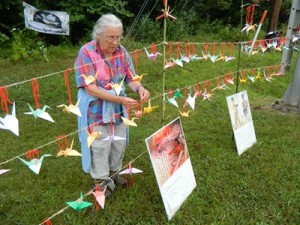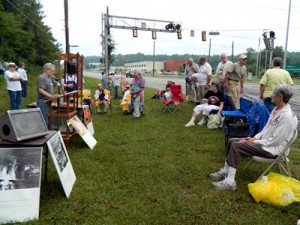
Sharon O’Hara-Bruce of Lake Orion, Mich., ties a peace crane to a fence set up in front of the Y-12 National Security during a Tuesday morning ceremony recalling the bombing of Hiroshima, Japan, on Aug. 6, 1945, near the end of World War II.
A few dozen demonstrators from across the eastern United States gathered near the Y-12 National Security Complex on Tuesday morning to remember the bombing of Hiroshima, Japan, near the end of World War II 68 years ago.
Some traveled hundreds of miles by bicycle and car to get to Oak Ridge, where they questioned the nation’s current energy policy and preparations for nuclear war. Four riders arrived after a 458-mile, nine-day “Bikes Not Bombs” trip from Cincinnati to Oak Ridge.
“It’s consciousness-raising and concern for the priorities of our society,” said Tim Kraus of Cincinnati, part of the support group for the “Bikes Not Bombs” trip, which was organized by Footprints for Peace. “What we’re doing is not sustainable.”
Uranium enriched at Y-12 was used in the atomic bomb dropped over Hiroshima on Aug. 6, 1945. Code-named “Little Boy,” it was the first nuclear weapon used in war. Some 140,000 people died in the attack on the city of 350,000 several hundred miles southwest of Tokyo.
Another 70,000 died when U.S. forces dropped another atomic bomb on Nagasaki, also southwest of Tokyo, three days later. Japan surrendered to allied forces on Aug. 14, ending one of the bloodiest and most far-reaching conflicts in history.

About 30 demonstrators gather for an annual ceremony on Aug. 6 at the Y-12 National Security Complex, recalling the bombing of Hiroshima, Japan, near the end of World War II 68 years ago.
Demonstrators at Tuesday’s ceremony in front of Y-12’s main entrance said they wanted to help prevent any more nuclear explosions or disasters.
“I’m here so that this never happens again,” said Sharon O’Hara-Bruce of Lake Orion, Mich.
She was born in 1945, right before the bombs were dropped. Many children in her generation were either very young or “in the womb” when the weapons were used, O’Hara-Bruce said. She said she and other members of her generation had nightmares about nuclear war when they were children.
“We heard the shrieks,” O’Hara-Bruce said.
Others, such as Jim Toren of Cincinnati’s FootPrints for Peace, questioned the government’s willingness to spend billions of dollars on nuclear weapons work and facilities, including the proposed multi-billion dollar Uranium Processing Facility at Y-12, when other social needs, such as education, could use more funding.

The annual Names and Remembrance ceremony includes Buddhist drumming and chanting. Pictured above facing the Y-12 National Security Complex are, left, Sister Mary Dennis Lentsch of Washburn, Tenn.; and, center, Larry Crane of Lexington, Ky.; Erik Johnson of Maryville; and Buddhist monk Gyoshu Utsumi of Newport.
Ralph Hutchison, coordinator of the Oak Ridge Environmental Peace Alliance, said there were about 30 demonstrators at Tuesday’s gathering at East Bear Creek and Scarboro roads, across from Y-12. They participated in a Names and Remembrance ceremony that included the reading of names of victims of Hiroshima, the pealing of a bell, and the presentation of peace cranes. There were also first-hand accounts of the bombing, poetry, and artwork of survivors. Demonstrators observed a moment of silence at 8:15 a.m., the time that “Little Boy” detonated over Hiroshima; the silence concluded with Buddhist drumming and chanting.
In previous years, the annual ceremony organized by OREPA had been on the other side of Scarboro Road, next to the green Y-12 sign. But the National Nuclear Security Administration and B&W Y-12 erected a fence around the front of the plant in April after three trespassing incidents involving five people in the past year, including the July 28, 2012, security breach. OREPA has challenged the fence in U.S. District Court in Knoxville, calling it an assault on their First Amendment rights.
The list of names of Hiroshima victims read Tuesday included Japanese residents and visitors in Hiroshima, as well as citizens of the United States, Germany, Australia, and other countries who were in Hiroshima on Aug. 6.
“I think it’s important to remember so that we can change the future,” Hutchison said.
Note: This story was updated at 9:40 p.m.
Leave a Reply